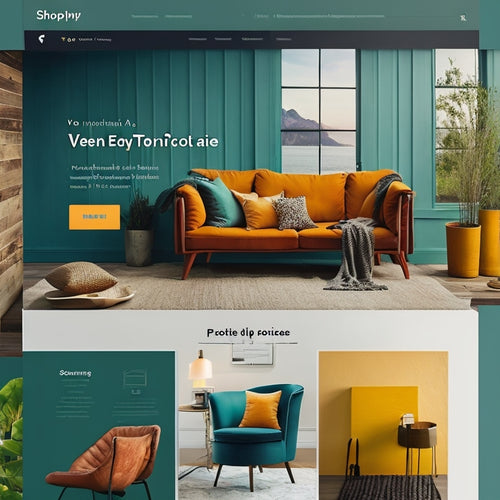The Importance of Interactive Shopping Experiences
Share
In today's digital age, businesses are constantly searching for innovative ways to engage consumers and increase sales. One such method that has gained significant traction is the use of interactive shopping experiences, particularly through shoppable videos.
These videos not only captivate viewers with engaging visual storytelling but also provide seamless purchasing options within the video itself. Moreover, they have proven to significantly enhance customer engagement and generate measurable results for brands.
As we delve into this article, we will explore the importance of interactive shopping experiences and uncover future trends and innovations in this space.
- Interactive shopping experiences reshape the retail landscape.
- Shoppable videos enhance customer engagement.
- Interactive shopping experiences revolutionize how consumers interact with brands.
- Shoppable videos provide a more immersive experience.
Engaging Visual Storytelling
Engaging visual storytelling plays a crucial role in creating interactive shopping experiences through shoppable videos. By utilizing immersive experiences and establishing an emotional connection with consumers, brands can effectively captivate their target audience and drive sales.
Immersive experiences are key to engaging customers and keeping them actively involved in the shopping process. Shoppable videos allow viewers to interact with the content by clicking on specific items showcased, leading them directly to the product page for purchase. This interactivity not only enhances user engagement but also provides a seamless transition from inspiration to action, eliminating any friction in the buying journey.
Furthermore, visual storytelling allows brands to establish an emotional connection with their audience. Through compelling narratives and visually appealing content, brands can evoke emotions such as excitement, desire, or nostalgia within consumers. These emotions enhance brand recall and foster a sense of belonging among customers.
Data-driven insights further reinforce the importance of engaging visual storytelling in driving sales. Studies have shown that shoppable videos generate higher conversion rates compared to traditional static images or text-based advertisements. This is attributed to the interactive nature of shoppable videos, which facilitates immediate purchases based on consumer interest.
In conclusion, engaging visual storytelling is essential for creating interactive shopping experiences through shoppable videos. By leveraging immersive experiences and establishing an emotional connection with customers, brands can effectively capture their attention and motivate them towards making a purchase decision. The data-driven insights support this approach as they indicate higher conversion rates associated with this type of content format.
Seamless Purchasing Options
Seamless purchasing options encompass a variety of features and functionalities that facilitate a smooth and convenient shopping experience for consumers. These options are designed to eliminate any obstacles or friction that may arise during the checkout process, ensuring seamless transactions.
One key feature of seamless purchasing options is convenient checkout. This refers to the ability for consumers to easily complete their purchases without unnecessary steps or complexities. For example, one-click checkout allows customers to make a purchase with just a single click, saving them time and effort. Similarly, autofill forms can automatically populate customer information, reducing the need for manual input and streamlining the checkout process.
In addition to convenient checkout, seamless purchasing options also aim to provide frictionless transactions. This means that payment methods should be quick, secure, and easy to use. Mobile payment solutions like Apple Pay and Google Pay allow consumers to make payments by simply tapping their smartphones or smartwatches at point-of-sale terminals. These methods not only expedite the transaction process but also enhance security by eliminating the need to share credit card details with merchants.
By incorporating these seamless purchasing options into their online platforms or physical stores, businesses can create an environment where consumers feel empowered and valued. Such convenience and ease in completing transactions foster loyalty among customers while attracting new ones who seek hassle-free shopping experiences.
Increasing Customer Engagement
To enhance customer interaction and involvement, businesses can implement strategies that promote active participation and foster a sense of community among consumers. This approach not only enhances customer satisfaction but also drives brand loyalty.
Here are three key strategies that can be implemented to increase customer engagement:
-
Personalized Recommendations: By using data analytics and machine learning algorithms, businesses can provide personalized product recommendations to customers based on their preferences and browsing history. This not only helps customers discover products they may be interested in but also makes them feel valued and understood by the brand.
-
Interactive Content: Creating interactive content such as quizzes, polls, or contests on social media platforms encourages customers to actively engage with the brand. This type of content fosters a sense of community among consumers as they interact with each other while participating in these activities.
-
User-Generated Content: Encouraging customers to share their experiences through reviews, testimonials, or user-generated content creates a sense of belonging within the brand's community. Customers feel empowered when their opinions are valued by the brand and this increases their emotional connection with the company.
By implementing these strategies, businesses can create interactive shopping experiences that not only enhance customer satisfaction but also drive brand loyalty by fostering a sense of belonging within their consumer community.
Measurable Results
Measurable results can be attained by implementing strategies that focus on customer engagement and involvement, fostering a sense of community and driving brand loyalty. One effective way to achieve this is through interactive shopping experiences, such as shoppable videos. These experiences allow customers to actively participate in the shopping process, leading to increased engagement and ultimately higher conversion rates.
Data analysis plays a crucial role in measuring the success of interactive shopping experiences. By tracking various metrics such as click-through rates, time spent interacting with the video, and conversion rates, businesses can gain valuable insights into customer behavior and preferences. This data-driven approach allows companies to optimize their strategies and tailor their offerings to meet customer needs more effectively.
One significant advantage of shoppable videos is their ability to capture customers' attention and keep them engaged throughout the entire shopping journey. Unlike traditional static advertisements, these videos offer an immersive experience that encourages customers to explore different products or services within a single platform. The longer exposure time combined with interactive features leads to higher conversion rates compared to other forms of advertising.
Furthermore, interactive shopping experiences foster a sense of community among customers. By allowing users to share their opinions, reviews, or recommendations within the platform itself, brands create a space where customers feel valued and included. This sense of belonging not only strengthens brand loyalty but also encourages repeat purchases and word-of-mouth referrals.
In conclusion, implementing interactive shopping experiences like shoppable videos can lead to measurable results in terms of increased customer engagement and higher conversion rates. By utilizing data analysis techniques, companies can optimize their strategies based on real-time insights. Additionally, these experiences foster a sense of community among customers which further drives brand loyalty.
Future Trends and Innovations
In the realm of future trends and innovations in shopping, Virtual Reality (VR) and Augmented Reality (AR) have emerged as significant technologies.
VR and AR provide immersive experiences that allow consumers to virtually explore products before making a purchase decision.
Additionally, personalized recommendations based on consumer preferences and browsing history enable retailers to deliver targeted suggestions, enhancing the shopping experience.
Lastly, customization is becoming increasingly popular as consumers seek unique products tailored to their individual needs and preferences, with advancements in technology enabling mass customization at a feasible cost.
These emerging trends are reshaping the retail landscape and have the potential to revolutionize how consumers interact with brands.
Virtual Reality and Augmented Reality in Shopping
Virtual Reality (VR) and Augmented Reality (AR) have revolutionized the shopping experience by allowing consumers to virtually try on products and visualize how they would look in real life. This technology has transformed the way people shop, providing a more interactive and immersive experience.
Here are four key ways in which VR and AR are changing the shopping landscape:
-
Virtual reality applications: VR allows customers to step into a virtual store environment, browse through products, and make purchases without leaving their homes.
-
Augmented reality technology: AR overlays digital information onto the real world, enabling customers to see how furniture or clothing items would fit into their space or how makeup would look on their face.
-
Enhanced product visualization: VR and AR enable customers to view products from different angles, zoom in for detailed inspection, and even test out functionalities before making a purchase.
-
Personalized experiences: With VR and AR, retailers can tailor shopping experiences based on individual preferences, offering personalized recommendations and creating a sense of belonging.
The integration of VR and AR into shopping not only enhances customer engagement but also increases sales conversions by providing a more immersive and personalized experience.
Personalized Recommendations and Customization
Retailers are able to provide tailored suggestions and customization options to customers through the integration of personalized recommendations and customization features. By analyzing customer data, retailers can offer personalized suggestions based on individual preferences, purchase history, and browsing behavior. This allows for a more targeted shopping experience, increasing the likelihood of customer satisfaction and repeat purchases.
Furthermore, customization options enable customers to personalize products according to their unique preferences, creating a sense of ownership and exclusivity. Research shows that personalized recommendations significantly impact purchasing decisions, with 49% of consumers stating that they have made impulse purchases based on personalized product recommendations. Moreover, 91% of consumers are more likely to shop with brands that provide relevant offers and recommendations.
By offering personalized suggestions and tailored options, retailers not only enhance the shopping experience but also foster a sense of belonging among customers by catering to their specific needs and desires.
Frequently Asked Questions
How can engaging visual storytelling enhance the overall shopping experience for customers?
Engaging visual storytelling in shopping enhances customer satisfaction and boosts brand loyalty. Through immersive experiences, customers feel connected to the brand, leading to increased trust and a sense of belonging, resulting in higher levels of satisfaction and loyalty.
What are some examples of seamless purchasing options that can be incorporated into shoppable videos?
Seamless purchasing options in shoppable videos include interactive features like embedded links, pop-up windows, and add-to-cart buttons. These features enable customers to make purchases directly within the video, enhancing convenience and streamlining the shopping process.
How can businesses increase customer engagement through interactive shopping experiences?
Businesses can increase customer engagement by incorporating interactive features in their shopping experiences, such as quizzes and polls. This enhances customer participation and satisfaction, leading to a sense of belonging and loyalty towards the brand.
What are some ways to measure the effectiveness and success of interactive shopping experiences?
Measuring success in interactive shopping experiences can be done through the use of analytics and metrics. These tools provide objective data that allows businesses to analyze customer engagement, conversion rates, and overall effectiveness.
What are some future trends and innovations that we can expect to see in the realm of interactive shopping experiences?
Virtual reality shopping and augmented reality try-ons are future trends in interactive shopping experiences. These innovations enhance customer engagement, provide a personalized shopping experience, and increase sales conversion rates by allowing customers to virtually try on products before purchasing them.
Related Posts
-

3 Best Online Courses for Entrepreneurial Success Today
You're likely no stranger to the challenges of building a successful online business, but you know that staying ahead...
-

Top Shopify Apps for Ecommerce Growth
This article provides an overview of the top Shopify apps for ecommerce growth. The background information includes ...
-

Customizable Contact Form Apps for Shopify
Customizable contact form apps for Shopify offer a range of features and customization options that enhance the func...


